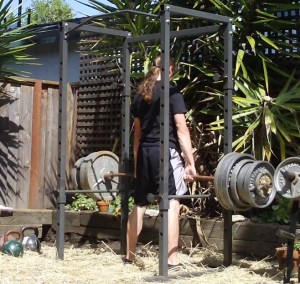I can’t believe I went all that time without a power rack! What a loss.
You can get strong in many different ways but if you want to push the limits of what you can do a power rack (or maybe I should call it a partials rack) becomes a necessity.
Partials are just what the name implies, a partial movement rather than a full range of a particular exercise. These are used in big, compound exercises like the deadlift, squat and presses, though other partials can certainly be used.
Why would you want to use only a part of the movement? It allows you to maximize your output at every part of the strength curve. Sorry if that sounded too scientific.
Lets take the deadlift as an example. What’s the hardest part of the lift? Right at the ground, or just above it. After that its usually smooth sailing. That’s cause at the top of the movement you have better leverage. So shouldn’t you make every range of movement as strong as possible, rather than just limiting it by what you can lift at the bottom?

A 605lb. Partial Deadlift in the Power Rack
If you are an athlete this is especially important. A punch is driven from the ground up right? But you don’t drop into a full squat before throwing one. This is the same for virtually all athletic movements. Training with partials will make these movements even stronger than the full range movements would.
There is carryover between the partials and full range lifts but you have to be smart about it. If you do a health lift or hands and thigh lift which are different names for a short range rack pull you won’t necessarily be able to pull more from the floor. But if you work both movements, and partials of a larger range your lifts will go up.
You do need to train in full range movements. You want the strength in every area, remember? But partials absolutely deserve a place in your training too. Despite the heavy weights the movements are quite safe as its hard to have bad form with such good leverage. Of course, the closer the partial gets to a full range movement the less this is true. If you want more information, I highly recommend the Partials DVD from Bud Jeffries. Its the only course solely devoted to partials and Bud probably has more experience with them than anyone else.
Back to the power rack. This makes doing partials not just easy, but possible. Without some sort of rack you won’t be able to do partials. There are a couple ways (setting your deadlift barbell on two raised platforms for instance) but not much.
Of course the rack also makes squats, partials and full range, easy. Squats are a great exercise but not the best for everyone. I’ve noticed that even since getting the rack I end up doing deadlifts more often than squats.
Power racks are in ample supply in commercial gyms but I stopped going there many years ago. Its not the easiest piece of equipment for the home gym but if you want to get strong its well worth the effort and cost. Its likely you can find a supplier locally (I got mine off of Craig list). Or there are tons of places online to get them. Even Amazon.com has a wide selection.
Just be weary. Not all power racks are created equal. When doing heavy partials (and trust me the weight goes up fast) you need to make sure the rack can handle it. Not all are capable of holding a 1000 lbs.
Get a rack. Start doing partials. Get stronger.

Comments
This is a great article, Logan. Thanks!
Logan,
I enjoyed this article, and your outdoor setup looks quite interesting. Partial deadlifts, especially if a thick bar is used, not only builds incredible muscle, tendon, and ligament power throughout the whole body, but is second to none for developing a gorilla-like grip. By the way, I think the new look for your handbalancing website looks very professional. Keep up the good work.
Rob
Great article on these partials…thanks!